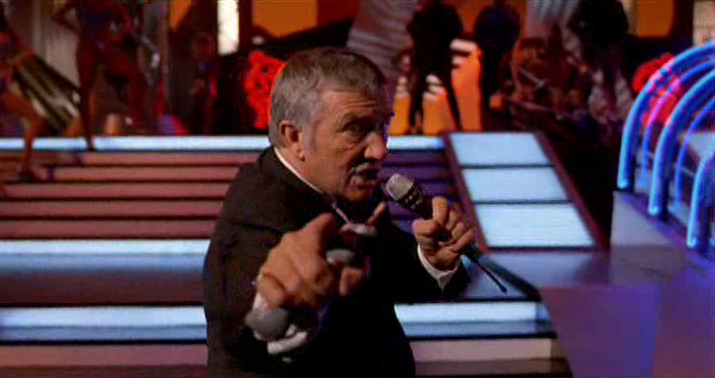“By 2017, the world economy has collapsed. Food, natural resources and oil are in short supply. A police state, divided into paramilitary zones, rules with an iron hand. Television is controlled by the state and a sadistic game show called The Running Man has become the most popular program in history…”
So reads the opening crawl of The Running Man, a Stephen King novel loosely adapted as a sci-fi action vehicle for brawny star Arnold Schwarzenegger in 1987. If you’ve been loitering around Twitter, you may be familiar with its angular white typeface set against a blood red background, as users have screencapped and shared it as a dry commentary about the real 2017 and what could be described as its more dystopian developments: food banks, Brexit, the President threatening nuclear war on social media, ITV game show Cannonball, and so forth.
Coming three years after Schwarzenegger’s fame blew up with The Terminator, and just a few months after Predator’s release in the summer of 1987, The Running Man could be regarded as second-tier Arnold. Its director, former Starsky & Hutch star Paul Michael Glaser, lacks the feel for action and suspense than James Cameron or John McTiernan, while the outrageous, satirical stuff – and there’s a lot of it – isn’t handled with the same glee that Paul Verhoeven brought to the classic Total Recall in 1990.
The Running Man, written by action thriller genius Steven E de Souza (Commando, Die Hard) retains a certain charm all the same. Besides, look beneath the scantily-clad dancers and 80s decor, and you’ll find a movie with several parallels to the version of 2017 we currently inhabit.
Let’s deal with the obvious first, given that it’s up there in the opening title crawl. A global recession has left America (and presumably the world) in the grip of a totalitarian dictatorship, where the media is strictly monitored by the state and disobedient citizens are carted off and quietly brainwashed. Schwarzenegger plays Ben Richards, a cop and helicopter pilot who’s sent off to a prison camp when he refuses orders to open fire on unarmed civilians.
After a botched escape attempt, Richards is selected as a ‘contestant’ on The Running Man – television’s number-one rated game show in which convicted criminals are hunted down by armoured assassins. The game show’s prizes include parole or even a full pardon (or so they’re told); losers are violently killed in front of a baying live audience.
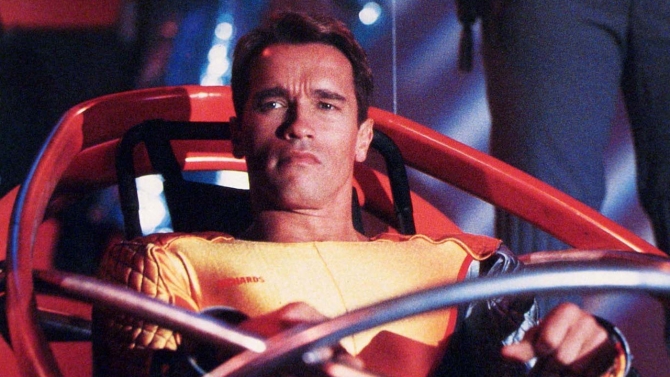
Cold-blooded presenter Damon Killian (Richard Dawson), nervous about the news that his ratings have peaked, chooses Richards as his latest contestant: “I can get ten points for his biceps alone,” Killian reasons. Within hours, Richards indeed becomes a TV sensation – though not for the reasons The Running Man’s host intended. The show’s superstar stalkers – Dynamo, Subzero, Buzzsaw – lie dead, and an armed group of freedom fighters (led by Mick Fleetwood, of all people) manage to take control of the whole network. Thanks to Richards, the revolution really will be televised.
Away from the Running Man show itself, the movie has a number of gadgets that will immediately jump out for 21st century audiences. When songwriter Amber (Maria Conchita Alonso) enters her apartment, we see that everything from her lighting to her home appliances are voice-activated. It’s the kind of gadgetry we see come up on tech sites all the time, and plenty of us are already used to using Amazon Echo, Siri or Google Now to do things like play music or change the temperature in our living rooms. When Richards attempts to escape from California, he books a pair of plane tickets to Hawaii using something called Cadre Infonet – a clear forerunner of the web running on Amber’s TV.
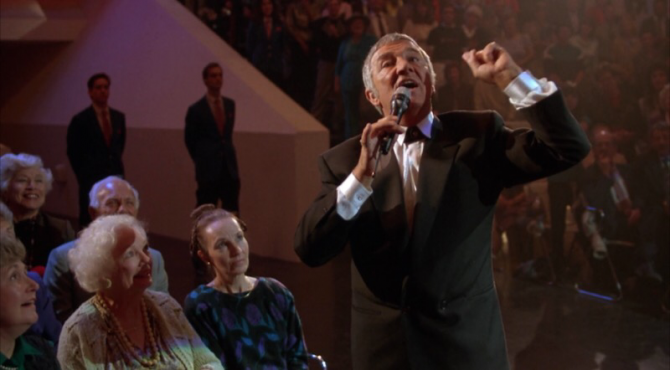
Note, too, how large, flat-panel televisions are ubiquitous in The Running Man‘s 21st century: the movie even correctly predicts that the TVs of the future will use a 16:9 aspect ratio rather than 4:3; some even have thin, chrome bezels round the edge. Not a bad prediction, given that 16:9 didn’t become the standard ratio for televisions until about a decade after The Running Man came out.
What The Running Man couldn’t have predicted is that, by the 2010s, television’s dominance has long since been overtaken by the web and smart devices. If the movie were made today, Killian’s show would as likely be watched on phones and tablets as a big TV. A totalitarian state probably wouldn’t stop at using a game show to pacify the masses, either; there’d probably be a tie-in app where viewers can choose which stalkers hunt down the week’s luckless contestant, or a videogame where players can kill fleeing criminals themselves.
Then again, The Running Man does show how easily digital media can be manipulated by those in control of it. The movie even contains examples of what we might now call ‘Fake News’. When Richards refuses state orders to kill starving protestors, footage of the event is edited and doctored to make it look as though Richards is the villain. Later, when Richards is apprehended at an airport, a news report cuts in images of dead law enforcers to back up the claim that he’d murdered people during the arrest.
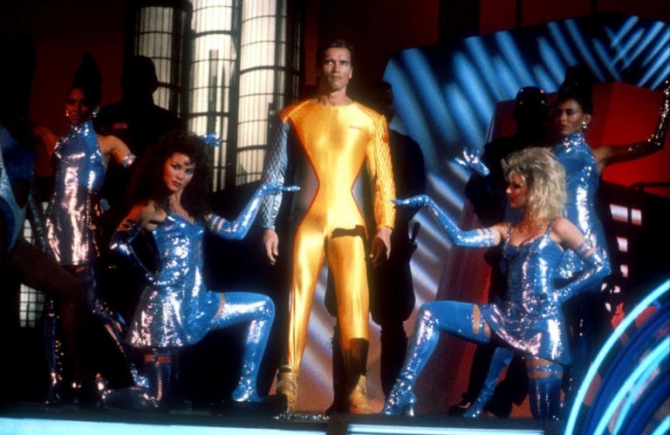
Later, we even see first-hand how existing video footage can be digitally manipulated to create the illusion of a real incident: TV station stooge Tony (Kurt Fuller) is shown at work at his console, making up a sequence where Richards is ‘killed’ by the stalker Captain Freedom (Jesse Ventura). Okay, so we probably aren’t in that kind of media landscape just yet, but given that the manipulation of information is such a hot-button issue in 2017, it’s fascinating to look back and see the notion come up in a big action movie from three decades ago.
The Running Man, like its predecessors Rollerball (1975) and The Prize Of Peril (1983) also managed to anticipate the rise of reality television. The Running Man show is a clear offshoot from wrestling and American football, not unlike the violent sport in Rollerball, but the movie aptly captures how TV networks can make money from shows that appeal to our darker impulses. We don’t have Climbing For Dollars or The Hate Boat (two rival shows in The Running Man universe) in our 2017, but in the UK alone, we do have things like Can’t Pay? We’ll Take It Away! (the vicarious thrill of watching people’s homes and belongings being repossessed). It also goes without saying that the current US president Donald Trump helped raise his profile by hosting the US reality TV show, The Apprentice.
In the midst of a big, loud Arnold Schwarzenegger action vehicle, it’s also worth noting that The Running Man doesn’t shy away from making the film’s public complicit in all the violence. Its makers are careful to show us that the show’s fans come from all sectors of society – yuppies in a bar, the lower classes in the street, sweet-looking old ladies in cardigans and pearls among the studio audience. When Richards kills his first stalker, there’s silence among this diverse audience – not because of all the gore and violence, but because one of their heroes has died.
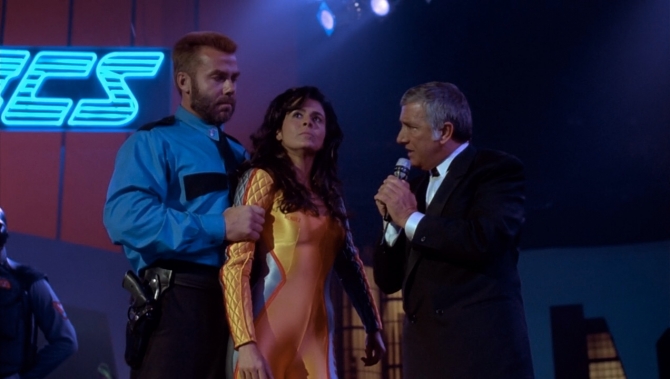
Admittedly, the audience thinks that Richards is a mass-murderer and not a victim of a manipulative regime; then again, note just how readily it eats up the illegal broadcasts put out by Mick Fleetwood and his revolutionaries. For all anyone knows, these new bits of footage – which show Richards as the innocent and Killian as the villain – could just be more fake news.
The viewers don’t really care about the truth so much as being fed a safe and easily-digestible narrative; when Richards starts killing the ‘heroic’ stalkers, the crowd grows nervous and silent. When they’re shown that Richards is the hero and that Killian’s the bad guy, they cheer and chant for their new-found hero. There’s no suggestion that the despotic regime has been toppled – only that its mouthpiece has been taken away, at least for a time. The regime’s leader remains safe in his bed, and the public, jeering at the sight of Killian’s body smashing into a cola sign, are as bloodthirsty as ever.
This, perhaps, is The Running Man’s lasting relevance in 2017, beyond the gadgets, fake news and reality television. We’re all to blame, at least in some small way, for the cultural and political climate in which we live. The villain in The Running Man isn’t Big Brother, the stalkers, or Damon Killian – it’s the viewers.

